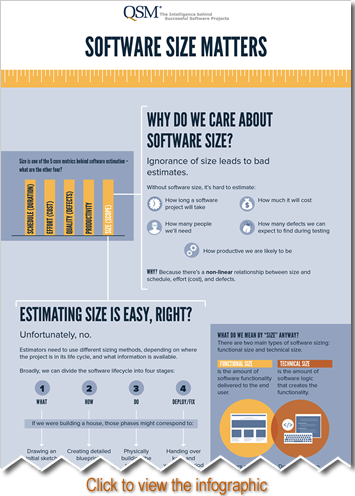Software is everywhere in modern life - from automobiles, airplanes, utilities, banks, to complex systems and global communications networks. They run the gamut from tiny applets that comprise just a handful of instructions to giant systems running millions of lines of code that take years to build.
Software professionals are at the front lines of this information revolution. This post addresses Frequently Asked Questions about measuring the size of software applications after they’re finished and estimating the work for a project that has yet to be started. We hope it will help software professionals do a better job of describing what they are building for their companies as software continues to grow in strategic importance to our companies and to our daily lives.
Question: What do we mean by the term, “Software Size”
Answer: For starters, think of T-shirts – Small, Medium, Large, or Extra-Large, or houses that can range from a small summer cottage all the way up to a 20,000 sq ft Hollywood mansion on a sprawling estate.
So it goes with software. You can have a small program with a few cool features, or a huge, complex computerized trading system for the New York Stock Exchange comprised of millions of lines of code, and everything in-between.
Question: I have a large project and its size is 20 people. Is that what you mean?
Answer: Not quite. That’s actually the number of the people on your team, or number of staff resources on the project. It’s not the amount of functionality, or the volume of software created by a team of that size.
Question: Ok, so you’re saying that small feature sets for a software program - or a long list of features - is what you mean by the size of the software. Do you also mean lines of code?
 I have been a software project estimator for 20 years. Like many people who have worked a long time in their profession, I find myself applying my work experience to other events in my life. So, when a family member tells me that he or she will be back from a trip into town at 3:30, I look at their past performance (project history) and what they propose to do (project plan) and add an hour. Usually, I am closer to the mark than they are.
I have been a software project estimator for 20 years. Like many people who have worked a long time in their profession, I find myself applying my work experience to other events in my life. So, when a family member tells me that he or she will be back from a trip into town at 3:30, I look at their past performance (project history) and what they propose to do (project plan) and add an hour. Usually, I am closer to the mark than they are.


 Dear Carol:
Dear Carol: